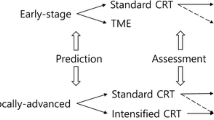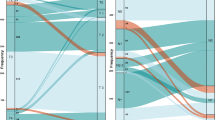Abstract
The treatment of rectal cancer has undergone tremendous changes in the past two decades due to improvements in preoperative treatment and introduction of the total mesorectal excision as standard surgical technique. However, this treatment could further be improved by the addition of biological information. Integration of biological information can be used at different time points along the treatment process. First, predictive markers could select the most efficient treatment for each patient. Similar markers could also follow patients during treatment and assess the need for intensifying the preoperative treatment in nonresponders. In good responders, organ preservation might be considered. This review addresses these different aspects of integration of biological information in the treatment of rectal cancer.
Similar content being viewed by others

References
Papers of particular interest, published recently, have been highlighted as: • Of importance •• Of major importance
MacFarlane JK, Ryall RD, Heald RJ: Mesorectal excision for rectal cancer. Lancet 1993, 341:457–460.
Kapiteijn E, Marijnen CA, Nagtegaal ID, et al.: Preoperative radiotherapy combined with total mesorectal excision for resectable rectal cancer. N Engl J Med 2001, 345:638–646.
Sauer R, Becker H, Hohenberger W, et al.: Preoperative versus postoperative chemoradiotherapy for rectal cancer. N Engl J Med 2004, 351:1731–1740.
Bosset JF, Collette L, Calais G, et al.: Chemotherapy with preoperative radiotherapy in rectal cancer. N Engl J Med 2006, 355:1114–1123.
Frattini M, Balestra D, Suardi S, et al.: Different genetic features associated with colon and rectal carcinogenesis. Clin Cancer Res 2004, 10(12 Pt 1):4015–4021.
Kapiteijn E, Liefers GJ, Los LC, et al.: Mechanisms of oncogenesis in colon versus rectal cancer. J Pathol 2001, 195:171–178.
Slattery ML, Curtin K, Wolff RK, et al.: A comparison of colon and rectal somatic DNA alterations. Dis Colon Rectum 2009, 52:1304–1311.
Garcia-Velasco A, Mendiola C, Sanchez-Munoz A, et al.: Prognostic value of hormonal receptors, p53, ki67 and HER2/neu expression in epithelial ovarian carcinoma. Clin Transl Oncol 2008, 10:367–371.
Tewari M, Krishnamurthy A, Shukla HS: Predictive markers of response to neoadjuvant chemotherapy in breast cancer. Surg Oncol 2008, 17:301–311.
Kimura T, Tanaka S, Haruma K, et al.: Clinical significance of MUC1 and E-cadherin expression, cellular proliferation, and angiogenesis at the deepest invasive portion of colorectal cancer. Int J Oncol 2000, 16:55–64.
Palmqvist R, Sellberg P, Oberg A, et al.: Low tumour cell proliferation at the invasive margin is associated with a poor prognosis in Dukes’ stage B colorectal cancers. Br J Cancer 1999, 79:577–581.
Debucquoy A, Machiels JP, McBride WH, Haustermans K: Integration of epidermal growth factor receptor inhibitors with preoperative chemoradiation. Clin Cancer Res 2010, 16:2709–2714.
de Bruin EC, van d, V, van de PS, et al.: Prognostic value of apoptosis in rectal cancer patients of the dutch total mesorectal excision trial: radiotherapy is redundant in intrinsically high-apoptotic tumors. Clin Cancer Res 2006, 12:6432–6436.
Schwandner O, Schiedeck TH, Bruch HP, et al.: Apoptosis in rectal cancer: prognostic significance in comparison with clinical histopathologic, and immunohistochemical variables. Dis Colon Rectum 2000, 43:1227–1236.
Brizel DM, Sibley GS, Prosnitz LR, et al.: Tumor hypoxia adversely affects the prognosis of carcinoma of the head and neck. Int J Radiat Oncol Biol Phys 1997, 38:285–289.
Hockel M, Knoop C, Schlenger K, et al.: Intratumoral pO2 predicts survival in advanced cancer of the uterine cervix. Radiother Oncol 1993, 26:45–50.
Brown JM: The hypoxic cell: a target for selective cancer therapy—eighteenth Bruce F. Cain Memorial Award lecture. Cancer Res 1999, 59:5863–5870.
Goethals L, Debucquoy A, Perneel C, et al.: Hypoxia in human colorectal adenocarcinoma: comparison between extrinsic and potential intrinsic hypoxia markers. Int J Radiat Oncol Biol Phys 2006, 65:246–254.
Rasheed S, Harris AL, Tekkis PP, et al.: Hypoxia-inducible factor-1alpha and -2alpha are expressed in most rectal cancers but only hypoxia-inducible factor-1alpha is associated with prognosis. Br J Cancer 2009, 100:1666–1673.
Rasheed S, Harris AL, Tekkis PP, et al.: Assessment of microvessel density and carbonic anhydrase-9 (CA-9) expression in rectal cancer. Pathol Res Pract 2009, 205:1–9.
Ferrara N: Vascular endothelial growth factor: basic science and clinical progress. Endocr Rev 2004, 25:581–611.
Yarden Y, Sliwkowski MX: Untangling the ErbB signalling network. Nat Rev Mol Cell Biol 2001, 2:127–137.
Lee JJ, Chu E: First-line use of anti-epidermal growth factor receptor monoclonal antibodies in metastatic colorectal cancer. Clin Colorectal Cancer 2007, 6(Suppl 2):S42–S46.
Bonner JA, Harari PM, Giralt J, et al.: Radiotherapy plus cetuximab for squamous-cell carcinoma of the head and neck. N Engl J Med 2006, 354:567–578.
•• Machiels JP, Sempoux C, Scalliet P, et al.: Phase I/II study of preoperative cetuximab, capecitabine, and external beam radiotherapy in patients with rectal cancer. Ann Oncol 2007, 18:738–744. This study and the one by Rodel et al. [26••] were the first to combine chemoradiotherapy and cetuximab in rectal cancer. Both studies showed the unexpected antagonistic effect between cetuximab with chemoradiotherapy in rectal cancer.
•• Rodel C, Arnold D, Hipp M, et al.: Phase I-II trial of cetuximab, capecitabine, oxaliplatin, and radiotherapy as preoperative treatment in rectal cancer. Int J Radiat Oncol Biol Phys 2008, 70:1081–1086. This study and the one by Machiels et al. [25••] were the first to combine chemoradiotherapy and cetuximab in rectal cancer. Both studies showed the unexpected antagonistic effect between cetuximab with chemoradiotherapy in rectal cancer.
Debucquoy A, Haustermans K, Daemen A, et al.: Molecular response to cetuximab and efficacy of preoperative cetuximab-based chemoradiation in rectal cancer. J Clin Oncol 2009, 27:2751–2757.
Willett CG, Kozin SV, Duda DG, et al.: Combined vascular endothelial growth factor-targeted therapy and radiotherapy for rectal cancer: theory and clinical practice. Semin Oncol 2006, 33:S35–S40.
Beer AJ, Haubner R, Sarbia M, et al.: Positron emission tomography using [18F]Galacto-RGD identifies the level of integrin alpha(v)beta3 expression in man. Clin Cancer Res 2006, 12:3942–3949.
Knights V, Cook SJ: De-regulated FGF receptors as therapeutic targets in cancer. Pharmacol Ther 2010, 125:105–117.
Machiels JP, Sempoux C, Scalliet P, et al.: Phase I/II study of preoperative cetuximab, capecitabine, and external beam radiotherapy in patients with rectal cancer. Ann Oncol 2007, 18:738–744.
Vanderstraeten B, Duthoy W, De Gersem W, et al.: [18F]fluoro-deoxy-glucose positron emission tomography ([18F]FDG-PET) voxel intensity-based intensity-modulated radiation therapy (IMRT) for head and neck cancer. Radiother Oncol 2006, 79:249–258.
Grosu AL, Souvatzoglou M, Roper B, et al.: Hypoxia imaging with FAZA-PET and theoretical considerations with regard to dose painting for individualization of radiotherapy in patients with head and neck cancer. Int J Radiat Oncol Biol Phys 2007, 69:541–551.
Toma-Dasu I, Dasu A, Brahme A: Dose prescription and optimisation based on tumour hypoxia. Acta Oncol 2009, 48:1181–1192.
Chao KS, Bosch WR, Mutic S, et al.: A novel approach to overcome hypoxic tumor resistance: Cu-ATSM-guided intensity-modulated radiation therapy. Int J Radiat Oncol Biol Phys 2001, 49:1171–1182.
Bentzen SM: Theragnostic imaging for radiation oncology: dose-painting by numbers. Lancet Oncol 2005, 6:112–117.
Thorwarth D, Eschmann SM, Paulsen F, Alber M: Hypoxia dose painting by numbers: a planning study. Int J Radiat Oncol Biol Phys 2007, 68:291–300.
Dirix P, Vandecaveye V, De Keyzer F, et al.: Dose painting in radiotherapy for head and neck squamous cell carcinoma: value of repeated functional imaging with (18)F-FDG PET, (18)F-fluoromisonidazole PET, diffusion-weighted MRI, and dynamic contrast-enhanced MRI. J Nucl Med 2009, 50:1020–1027.
Habr-Gama A, Perez RO, Nadalin W, et al.: Operative versus nonoperative treatment for stage 0 distal rectal cancer following chemoradiation therapy: long-term results. Ann Surg 2004, 240:711–717.
Capirci C, Rubello D, Pasini F, et al.: The role of dual-time combined 18-fluorodeoxyglucose positron emission tomography and computed tomography in the staging and restaging workup of locally advanced rectal cancer, treated with preoperative chemoradiation therapy and radical surgery. Int J Radiat Oncol Biol Phys 2009, 74:1461–1469.
• Janssen MH, Ollers MC, van Stiphout RG, et al.: Evaluation of early metabolic responses in rectal cancer during combined radiochemotherapy or radiotherapy alone: sequential FDG-PET-CT findings. Radiother Oncol 2010, 94:151–155. This was the first study in rectal cancer in which several FDG-PET scans were performed during treatment to assess the use of FDG-PET to identify (non-)responders during chemoradiation. Identification of nonresponding patients early on during treatment could allow us to reorient nonresponding patients.
Koh DM, Collins DJ: Diffusion-weighted MRI in the body: applications and challenges in oncology. AJR Am J Roentgenol 2007, 188:1622–1635.
Patterson DM, Padhani AR, Collins DJ: Technology insight: water diffusion MRI—a potential new biomarker of response to cancer therapy. Nat Clin Pract Oncol 2008, 5:220–233.
Vandecaveye V, De KF, Hermans R: Diffusion-weighted magnetic resonance imaging in neck lymph adenopathy. Cancer Imaging 2008, 8:173–180.
• Sun YS, Zhang XP, Tang L, et al.: Locally advanced rectal carcinoma treated with preoperative chemotherapy and radiation therapy: preliminary analysis of diffusion-weighted MR imaging for early detection of tumor histopathologic downstaging. Radiology 2010, 254:170–178. This was the first study in rectal cancer to show the potential of DW-MRI to predict and monitor early therapeutic response in patients with rectal carcinoma undergoing radiochemotherapy.
Seicean R, Funariu G, Seicean A: Molecular prognostic factors in rectal cancer. Rom J Gastroenterol 2004, 13:223–231.
Galon J, Costes A, Sanchez-Cabo F, et al.: Type, density, and location of immune cells within human colorectal tumors predict clinical outcome. Science 2006, 313:1960–1964.
Shia J, Guillem JG, Moore HG, et al.: Patterns of morphologic alteration in residual rectal carcinoma following preoperative chemoradiation and their association with long-term outcome. Am J Surg Pathol 2004, 28:215–223.
Debucquoy A, Libbrecht L, Roobrouck V, et al.: Morphological features and molecular markers in rectal cancer from 95 patients included in the European Organisation for Research and Treatment of Cancer 22921 trial: prognostic value and effects of preoperative radio (chemo) therapy. Eur J Cancer 2008, 44:791–797.
Disclosures
No potential conflict of interest relevant to this article was reported.
Author information
Authors and Affiliations
Corresponding author
Rights and permissions
About this article
Cite this article
Debucquoy, A., Haustermans, K. How Might Knowledge of the Molecular Biology of Rectal Cancer Aid Us in Deciding Treatment?. Curr Colorectal Cancer Rep 6, 221–227 (2010). https://doi.org/10.1007/s11888-010-0065-y
Published:
Issue Date:
DOI: https://doi.org/10.1007/s11888-010-0065-y



